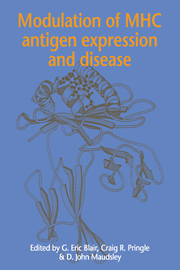Book contents
- Frontmatter
- Contents
- List of contributors
- Preface
- List of abbreviations
- 1 General introduction to the MHC
- 2 Organization of the MHC
- 3 Interactions of cytokines in the regulation of MHC class I and class II antigen expression
- 4 Control of MHC class I gene expression
- 5 Control of MHC class II gene expression
- 6 Modulation of MHC antigen expression by viruses
- 7 Modulation of MHC antigen expression by retroviruses
- 8 Modulation of MHC class I antigen expression in adenovirus infection and transformation
- 9 MHC expression in HPV-associated cervical cancer
- 10 Inhibition of the cellular response to interferon by hepatitis B virus polymerase
- 11 Cellular adhesion molecules and MHC antigens in cells infected with Epstein-Barr virus: implications for immune recognition
- 12 Effect of human cytomegalovirus infection on the expression of MHC class I antigens and adhesion molecules: potential role in immune evasion and immunopathology
- 13 Oncogenes and MHC class I expression
- 14 Mechanisms of tumour cell killing and the role of MHC antigens in experimental model systems
- 15 Manipulation of MHC antigens by gene transfection and cytokine stimulation: a possible approach for pre-selection of suitable patients for cytokine therapy
- 16 Overexpression of MHC proteins in pancreatic islets: a link between cytokines, viruses, the breach of tolerance and insulindependent diabetes mellitus?
- 17 The role of cytokines in contributing to MHC antigen expression in rheumatoid arthritis
- 18 Expression of an MHC antigen in the central nervous system: an animal model for demyelinating diseases
- Index
4 - Control of MHC class I gene expression
Published online by Cambridge University Press: 11 September 2009
- Frontmatter
- Contents
- List of contributors
- Preface
- List of abbreviations
- 1 General introduction to the MHC
- 2 Organization of the MHC
- 3 Interactions of cytokines in the regulation of MHC class I and class II antigen expression
- 4 Control of MHC class I gene expression
- 5 Control of MHC class II gene expression
- 6 Modulation of MHC antigen expression by viruses
- 7 Modulation of MHC antigen expression by retroviruses
- 8 Modulation of MHC class I antigen expression in adenovirus infection and transformation
- 9 MHC expression in HPV-associated cervical cancer
- 10 Inhibition of the cellular response to interferon by hepatitis B virus polymerase
- 11 Cellular adhesion molecules and MHC antigens in cells infected with Epstein-Barr virus: implications for immune recognition
- 12 Effect of human cytomegalovirus infection on the expression of MHC class I antigens and adhesion molecules: potential role in immune evasion and immunopathology
- 13 Oncogenes and MHC class I expression
- 14 Mechanisms of tumour cell killing and the role of MHC antigens in experimental model systems
- 15 Manipulation of MHC antigens by gene transfection and cytokine stimulation: a possible approach for pre-selection of suitable patients for cytokine therapy
- 16 Overexpression of MHC proteins in pancreatic islets: a link between cytokines, viruses, the breach of tolerance and insulindependent diabetes mellitus?
- 17 The role of cytokines in contributing to MHC antigen expression in rheumatoid arthritis
- 18 Expression of an MHC antigen in the central nervous system: an animal model for demyelinating diseases
- Index
Summary
Introduction
This chapter deals with transcriptional regulation of MHC class I genes in normal physiology and development. The main focus is transcription factors involved in regulating class I gene expression and the mechanism of action of these factors.
Class I genes are widely expressed in many adult tissues. However, levels of class I expression vary among different tissues; some tissues do not express class I genes at a significant level (Klein, 1975). While lymphoid tissues express class I genes at high levels, there is virtually no expression in the CNS. The lack of class I gene expression in the CNS constitutes a unique immunological environment, which accounts for persistent infection by some viruses (Joly, Mucke & Oldstone, 1991). Other tissues, such as pancreas and muscle, appear to be low in class I gene expression (David-Watine, Israel & Kourilsky, 1990a). Class I gene expression is developmentally controlled: class I mRNAs are not found until mouse embryos reach mid-somite stage (Ozato, Wan & Orrison, 1985). Levels of MHC class I expression in embryonic tissues vary but are higher in haemato/lymphopoietic tissues than in other tissues (Hedley et al, 1989). Class I mRNA levels rise sharply during the first week of neonatal development in the mouse (Kasik, Wan & Ozato, 1987). So far, the molecule responsible for the primary onset of class I expression during embryogenesis, or that which triggers the second, post-natal upsurge of class I expression, has not been identified.
- Type
- Chapter
- Information
- Modulation of MHC Antigen Expression and Disease , pp. 80 - 102Publisher: Cambridge University PressPrint publication year: 1995
- 1
- Cited by



